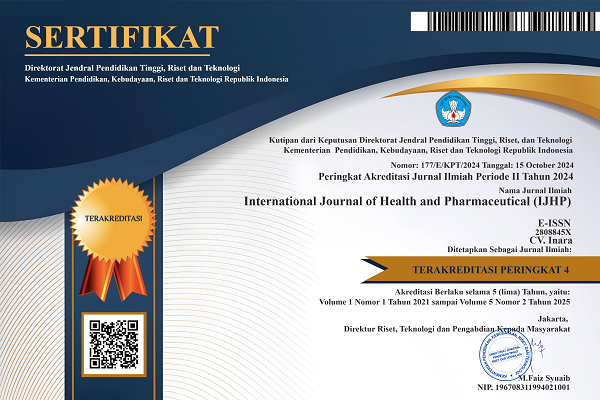Trends in Artificial Intelligence Research in Urology, Anesthesiology, Cardiology, and Otolaryngology: A Bibliometric Analysis (2019-2024)
DOI:
https://doi.org/10.51601/ijhp.v5i1.403Abstract
Background: The application of Artificial Intelligence (AI) in medicine is rapidly evolving, particularly in urology, anesthesiology, cardiology, and otolaryngology (ENT). AI is utilized in image-based diagnosis, patient monitoring, as well as the optimization of therapy and robotic surgery. However, research trends in AI within these fields have not yet been comprehensively mapped. Methods: This study employs bibliometric analysis to evaluate publication trends in AI across these four medical fields from 2019 to 2024. Data were collected from Google Scholar, PubMed, and Scopus, then analyzed using VOSviewer and R-Bibliometrix to identify the number of publications, keyword trends, institutional collaboration networks, and the most highly cited articles. Results: The number of AI-related publications in medicine has increased from 50 articles in 2019 to 130 articles in 2024. The United States, China, and the United Kingdom have the highest number of publications. Research trends indicate that deep learning and machine learning dominate, with broad applications in disease diagnostics and medical imaging. Cluster analysis reveals four main domains: anesthesiology (120 publications), cardiology (105 publications), urology (98 publications), and ENT (80 publications). Conclusion: AI has become an essential component in the advancement of modern medicine. With the increasing number of studies and multidisciplinary collaborations, AI is projected to continue expanding in data-driven diagnosis and therapy. However, challenges in clinical validation, regulation, and AI ethics must be addressed to ensure its safe and effective use.
Downloads
References
Topol EJ. High-performance medicine: the convergence of human and artificial intelligence. Nat Med. 2019;25(1):44-56.
Liu X, Faes L, Kale AU, et al. A comparison of deep learning performance against health-care professionals in detecting diseases from medical imaging: a systematic review and meta-analysis. Lancet Digit Health. 2019;1(6):e271-97.
Rajkomar A, Dean J, Kohane I. Machine learning in medicine. N Engl J Med. 2019;380(14):1347-58.
Reddy S, Fox J, Purohit MP. Artificial intelligence-enabled healthcare delivery. J R Soc Med. 2019;112(1):22-8.
Sartika, D. ., & Masluroh, M. (2024). The Influence of Health Counseling About Danger Signs for Infants Aged 0-12 Months on the Activeness of Mothers Going to Posyandu at Posyandu Balla Satanetean, Balla District, Mamasa Regency. International Journal of Health and Pharmaceutical (IJHP), 4(1), 28–32. https://doi.org/10.51601/ijhp.v4i1.262
Litjens G, Kooi T, Bejnordi BE, et al. A survey on deep learning in medical image analysis. Med Image Anal. 2017;42:60-88.
Ahmed HU, et al. Diagnostic accuracy of multi-parametric MRI and TRUS biopsy in prostate cancer. Lancet. 2017;389(10071):815-22.
London AJ, Kimmelman J. Clinical trial integrity and the ethics of machine learning in medicine. JAMA. 2018;320(14):1463-4.
Subramani S, Kothari A, Wang S, et al. Machine learning-based predictive models for postoperative pain management. Pain Med. 2021;22(6):1273-83.
Attia ZI, et al. Screening for cardiac contractile dysfunction using an AI-enabled electrocardiogram. Nat Med. 2019;25(1):70-4.
Hannun AY, Rajpurkar P, et al. Cardiologist-level arrhythmia detection in ECGs using deep neural networks. Nat Med. 2019;25(1):65-9.
Avram R, Olgin JE. Machine learning and wearable devices in cardiovascular medicine. J Am Coll Cardiol. 2020;75(11):1324-35.
Yu KH, Beam AL, Kohane IS. Artificial intelligence in healthcare. Nat Biomed Eng. 2018;2(10):719-31.
Ngguna, R. ., Erlina Puspitaloka Mahadewi, Gisely Vionalita, & Handayani, R. . (2022). Analysis of Patient Satisfaction on the Quality of Physiotherapy Services in the Pandemic Era at the SHC. International Journal of Health and Pharmaceutical (IJHP), 2(3), 418–424. https://doi.org/10.51601/ijhp.v2i3.49.
Cirillo D, Valencia A. Big data analytics for personalized medicine. Curr Opin Biotechnol. 2019;58:161-7.
Wong MC, Fung FH, Tong KL, et al. Trends in AI applications in urology: a bibliometric analysis. World J Urol. 2023;41(6):987-96.
Yildirim M, Bingol H, Cengil E, et al. AI-based classification of particles in urine sediment tests. Diagnostics (Basel). 2023;13(7):1299.
Adachi H, Suzuki S, Fukuda D, et al. Artificial intelligence in cardiovascular medicine. J Cardiol. 2022;79(4):417-25.
Bohr A, Memarzadeh K. The rise of artificial intelligence in healthcare applications. Future Sci OA. 2020;6(2):FSO455.
Esteva A, Robicquet A, Ramsundar B, et al. A guide to deep learning in healthcare. Nat Med. 2019;25(1):24-9.
Bzdok D, Meyer-Lindenberg A. Machine learning for precision psychiatry: opportunities and challenges. Biol Psychiatry Cogn Neurosci Neuroimaging. 2018;3(3):223-30.
Donthu N, Kumar S, Pattnaik D. Forty-five years of Journal of Business Research: A bibliometric analysis. J Bus Res. 2020;109:1-14.
Van Eck NJ, Waltman L. Software survey: VOSviewer, a computer program for bibliometric mapping. cientometrics. 2010;84(2):523-38.
Aria M, Cuccurullo C. bibliometrix: An R-tool for comprehensive science mapping analysis. J Informetr. 2017;11(4):959-75.
Zupic I, Čater T. Bibliometric methods in management and organization. Organ Res Methods. 2015;18(3):429-72.
Wang Y, Kung LA, Byrd TA. Big data analytics: Understanding its capabilities and potential benefits for healthcare organizations. Technol Forecast Soc Change. 2018;126:3-13.
Downloads
Published
Issue
Section
License
Copyright (c) 2025 Muhammad Sidharta Krisna, Muhammad Alfi Reza, Muamar Ghiffary, Muhammad Satir Sayati, Muhammad Awaluddin

This work is licensed under a Creative Commons Attribution-NonCommercial 4.0 International License.























